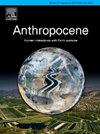Pastoralism and mining activities affecting timberline ecosystems in the Italian Alps during the last millennia
IF 3.3
2区 地球科学
Q2 ENVIRONMENTAL SCIENCES
引用次数: 0
Abstract
Historical ecology and palaeoecology provide a key for understanding the last millennia’s landscape changes, by reconstructing the chain of ecological/anthropogenic events that generated the current dynamics of the living systems. We analysed co-registered bio- and geoecological proxies (micro-botanical data, charcoal fragments, elemental abundance, nutrients), retrieved from a subalpine mire in Valmalenco, Italian Alps, to infer the main environmental transformations that led to the current larch-parkland-pasture landscape typical of timberline elevations in the Alps. The radiocarbon-dated record begins ca. BC 1300 with a primary forest formed by Pinus cembra, Picea excelsa and Larix decidua already affected by anthropogenic disturbance. Human impact increases during Early Iron Age with the development of mining activities and pastoralism. Local fires occurred in the Iron-Roman Ages; but from AD 1035, the primary forest experiences a definitive collapse to clear space for pastures during a climatically favourable phase. Lead enrichment unravels smelting activities that contributed to century-scale human impact increase. Critical minerogenic intake in Spundascia’s mire are related to the severe environmental conditions established during the Little Ice Age. In the Modern Age, pasture is carried even within the mire, as indicated by abundance of spores of coprophilous fungi. In conclusion, it is the last millennium of mostly anthropogenic drivers, enhanced by positive climate feedback, which overturned the ecological trajectories towards the modern setting of pasture intensity, eutrophication and fire disturbance.
在过去的一千年里,畜牧业和采矿活动影响了意大利阿尔卑斯山的树带线生态系统
历史生态学和古生态学通过重建产生当前生命系统动态的生态/人为事件链,为理解过去千年的景观变化提供了一把钥匙。我们分析了从意大利阿尔卑斯山Valmalenco亚高山沼泽中提取的生物和地球生态指标(微植物学数据、木炭碎片、元素丰度、营养物质),以推断导致阿尔卑斯山当前典型的落叶松-公园-牧场景观的主要环境转变。放射性碳定年记录始于公元前1300年左右,由松、云杉和落叶松形成的原始森林已经受到人为干扰。在早期铁器时代,人类的影响随着采矿活动和畜牧业的发展而增加。当地的火灾发生在铁器罗马时代;但从公元1035年开始,在气候有利的阶段,原始森林经历了一次决定性的崩溃,为牧场腾出了空间。铅富集揭示了导致百年人类影响增加的冶炼活动。Spundascia沼泽的临界成矿摄取量与小冰期形成的恶劣环境条件有关。在现代,牧草甚至被带进沼泽,这是由大量的粪菌孢子所表明的。综上所述,在气候正反馈的推动下,以人为驱动因素为主的最后一千年颠覆了放牧强度、富营养化和火灾干扰等现代环境的生态轨迹。
本文章由计算机程序翻译,如有差异,请以英文原文为准。
求助全文
约1分钟内获得全文
求助全文
来源期刊

Anthropocene
Earth and Planetary Sciences-Earth and Planetary Sciences (miscellaneous)
CiteScore
6.30
自引率
0.00%
发文量
27
审稿时长
102 days
期刊介绍:
Anthropocene is an interdisciplinary journal that publishes peer-reviewed works addressing the nature, scale, and extent of interactions that people have with Earth processes and systems. The scope of the journal includes the significance of human activities in altering Earth’s landscapes, oceans, the atmosphere, cryosphere, and ecosystems over a range of time and space scales - from global phenomena over geologic eras to single isolated events - including the linkages, couplings, and feedbacks among physical, chemical, and biological components of Earth systems. The journal also addresses how such alterations can have profound effects on, and implications for, human society. As the scale and pace of human interactions with Earth systems have intensified in recent decades, understanding human-induced alterations in the past and present is critical to our ability to anticipate, mitigate, and adapt to changes in the future. The journal aims to provide a venue to focus research findings, discussions, and debates toward advancing predictive understanding of human interactions with Earth systems - one of the grand challenges of our time.
 求助内容:
求助内容: 应助结果提醒方式:
应助结果提醒方式:


